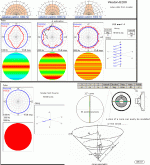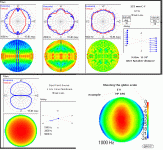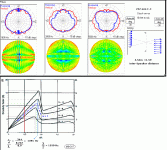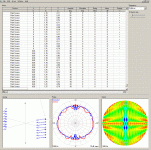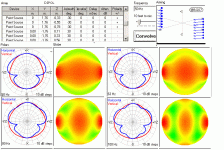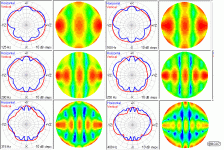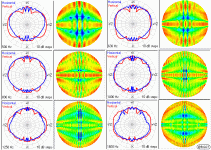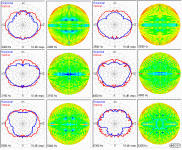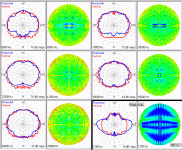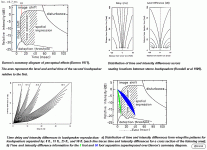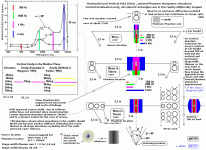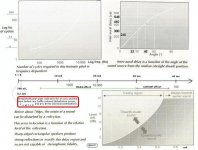…Can you do some additional explanations what we can see there?….etc + Dave and Lynn….
Hi all,
A lot of questions … For the moment Im too occupied to write extensive explanations, but if of any help; The ArraySHOW program is free and available from here:
http://www.electrovoice.com/tech-library.php?pt=3
Be sure to get version 1.1 build 63 as it works well almost without bugs.
Some further reading can be found at: http://www.prosoundweb.com/install/synaudcon/tt26_3/tt26_3.php
The main purpose of this program is the use for speaker set-ups using polar data from real measurements.
I mostly use the provided point source element for other various purposes like the transferring of my own real driver polar measurements to ArrayShow ….
Here is a link that might give an inspiration, addressing the part of ‘Behaviour of the cone in the frequency range’:
http://www.far-audio.com/modelisation.php
Im sorry you’ve found the resolution of my gif’s to low. I cut the first gif picture into 5 pieces and added a bunch. See the submitted pictures.
Tell me if some one wants any of the other to be magnified. It will take some time, as I don’t have saved any higher resolution copies, I have to redo all.
b
1(14)
Hi all,
A lot of questions … For the moment Im too occupied to write extensive explanations, but if of any help; The ArraySHOW program is free and available from here:
http://www.electrovoice.com/tech-library.php?pt=3
Be sure to get version 1.1 build 63 as it works well almost without bugs.
Some further reading can be found at: http://www.prosoundweb.com/install/synaudcon/tt26_3/tt26_3.php
The main purpose of this program is the use for speaker set-ups using polar data from real measurements.
I mostly use the provided point source element for other various purposes like the transferring of my own real driver polar measurements to ArrayShow ….
Here is a link that might give an inspiration, addressing the part of ‘Behaviour of the cone in the frequency range’:
http://www.far-audio.com/modelisation.php
Im sorry you’ve found the resolution of my gif’s to low. I cut the first gif picture into 5 pieces and added a bunch. See the submitted pictures.
Tell me if some one wants any of the other to be magnified. It will take some time, as I don’t have saved any higher resolution copies, I have to redo all.
b
1(14)
Attachments
Good stuff, especially the last three charts! I noted the comment in the last chart about reflections in the 0~700 uSec region degrading stereo image perception - exactly right! Those distances aren't large - that's 10 inches or 25 cm, as you like.
Unfortunately, not only are sharp-edged speaker cabinets the offenders here, but so are closely-spaced arrays, when you work out the arrival-time discrepancies of a straight-line array. That's why I only want to use all of the drivers together at the lowest frequencies (below 125 Hz), first low-passing the 15" driver closet to the floor, then low-passing the driver above that, etc. I'd like to thank Zaph and Jeff Bagby for the "cascade" crossover that would be useful for the 2.5.5 ... n LF array.
Preventing reflections in the 0~700 uSec region is also one more reason to use curved edges on a dipole as well as heavy wool felt on the back surface and vertical mounting struts.
Unfortunately, not only are sharp-edged speaker cabinets the offenders here, but so are closely-spaced arrays, when you work out the arrival-time discrepancies of a straight-line array. That's why I only want to use all of the drivers together at the lowest frequencies (below 125 Hz), first low-passing the 15" driver closet to the floor, then low-passing the driver above that, etc. I'd like to thank Zaph and Jeff Bagby for the "cascade" crossover that would be useful for the 2.5.5 ... n LF array.
Preventing reflections in the 0~700 uSec region is also one more reason to use curved edges on a dipole as well as heavy wool felt on the back surface and vertical mounting struts.
Bump.
I've enjoyed following this thread daily so didn't want to see it drop off into the nothingness.
Keep up the good work chaps.
I've enjoyed following this thread daily so didn't want to see it drop off into the nothingness.
Keep up the good work chaps.
Re: The Story So Far, Part II
Or the RAAL 140-15D ribbon Lynn also mentioned ?
?
Has anyone started on this build ?
Lynn Olson said:-----------
HF: BMS 4540ND or 4552ND ring-radiator 1" compression drivers, with preference to the 4540ND. There are several interesting horns: 18Sound XT1086, Azurahorn AH-550
Or the RAAL 140-15D ribbon Lynn also mentioned
 ?
?....
Highpass filter somewhere between 2 ~ 3 kHz, slope 12 to 24 dB/octave, depending on what meshes best with the widerange 12" driver
...
Widerange: 18Sound 12NDA520
...
There should be a 1st-order lowpass filter coming in around 1.5~1.8 kHz, possibly steepening to 2nd-order around 3 kHz - or in other words, a low-Q 2nd/order filter around 2 kHz. A highpass filter around 125 to 200 Hz is optional, although finding good-sounding caps in that value is going to be almost impossible. If you're going to multi-amp, though, a highpass setting in that range would probably be a good starting point.
....
Midbass: 12" Alnico Tone Tubby in 16-ohm version. The midbass region is where the combination of Alnico and the big hemp cone really shines, with vivid, dynamic tone colors. I see no problem running the 18Sound and TT together - the 12NDA520 uses a "high-damping" curvilinear wood pulp paper cone, a traditional material that should mesh with the TT just fine.
The midbass driver should share the 2 kHz lowpass filter of the 12NDA520, and have an additional 6 dB/octave filter somewhere between 160 and 250 Hz, compensating for the 1/f dipole loss of the 12NDA520. A tapped inductor is a good way to tune the midbass driver to the room.
Bass: 15" Tone Tubby in 16-ohm version, or any other 15, 18, or larger high-Q traditionally-built bass driver. This is mounted with the edge of the driver close to the floor, with the bass module (if separate) having swept side wings (drawing to come). Big Is Good for this frequency range and application. (C'mon down, Hartley fans! Join the party!)
The bass driver should share the 2 kHz lowpass filter of the 12NDA520, and have an additional 6 dB/octave filter between 80 and 125 Hz. Maybe it should also share the 160~250 Hz lowpass filter of the midbass driver - this to be determined by measurement and audition.
The widerange, midbass, and bass drivers are all connected in parallel at the lowest frequencies, giving an effective 4-ohm impedance below 50 Hz. Any competently designed amplifier, including 45 and 2A3 SET's, should drive the speaker with no problems - that's what the 4-ohm tap on the output transformer is for, after all. Discounting the 1/f loss, the 3 bass drivers working in parallel have an efficiency of 106 dB/metre! In practice, I expect the overall system efficiency to be similar to the 12NDA520's Theile/Small efficiency of 99 dB/metre.
This system is the one I like the most.
Has anyone started on this build ?
Hi All,
I've followed this thread with great interest. I'll toss in one data point, if I may. My current system is shown here: http://www.diyaudio.com/forums/showthread.php?s=&threadid=69906&highlight="unity+horn" The crossover arrangement is described in the last couple of posts on the second page. I have filled the horns with open cell foam, per Earl Geddes and that pretty much eliminated any slight horn character - at least to my ears. I've played with a variety of amps, depending on how much power I want.
So here's the relevant info: I had done a couple of quick tries in the past of leaving the mids disconnected and crossing the woofer set with the TAD only. This thread motivated me to give it a little more effort. So I tried a variety of crossover points from 900Hz to 3.5kHz, and various slopes, all digital and mostly 48dB, but some steeper.
I should also note that the speakers are about 1.5M from the rear wall. I have them toed in to cross slightly in front of the center listening position. I had previously taken the rear cover off the TAD's and replaced them with a couple of layers of medium heavy cloth (to attenuate the upper end a bit). This "dipole" arrangement gave a noticable increase in the depth of the image and an increase in the sense of space.
The differences between the various crossovers were fairly subtle at the center listening position. At a crossover point above about 1200kHz the highs and image softened some when listening off center. Tonally, things were fine in all cases. However, the image quality was still a step better when using the midranges as described in my Unity thread.
Now, a couple of caveats: Limited testing, one set of ears, so weigh accordingly. Also, I know the digital filter approach is not what many want. I too, will probably work my way toward a combination of passive line and passive speaker crossovers, at least on the upper end. Will probably stay with active on the lower end. The upside of the DEQX is that it allows one to try many different combinations quickly, and it's easier (though not as flexible) as the full PC approach as exemplified by Shinobiwan. I think too, though I haven't done much testing, that the time alignment allows a very clear presentation.
The Unity is essentially a single point source, multiple driver arrangement. The improved image quality gained by the lower crossover to the horn, may be attributable to having the mid and upper frequencies closer in space than they would be with a large widerange crossed to a tweeter. So, my take on this is that Lynns coaxial approach, if good integration can be had between horn and widerange, might be the way to go for systems where full scale dynamics and an effective image illusion are the goal.
I'm picking up some smaller widerange alnico's and I'm going to try those with a tweeter as an alternative to the horn. It'll be interesting to see how that sounds.
Sheldon
I've followed this thread with great interest. I'll toss in one data point, if I may. My current system is shown here: http://www.diyaudio.com/forums/showthread.php?s=&threadid=69906&highlight="unity+horn" The crossover arrangement is described in the last couple of posts on the second page. I have filled the horns with open cell foam, per Earl Geddes and that pretty much eliminated any slight horn character - at least to my ears. I've played with a variety of amps, depending on how much power I want.
So here's the relevant info: I had done a couple of quick tries in the past of leaving the mids disconnected and crossing the woofer set with the TAD only. This thread motivated me to give it a little more effort. So I tried a variety of crossover points from 900Hz to 3.5kHz, and various slopes, all digital and mostly 48dB, but some steeper.
I should also note that the speakers are about 1.5M from the rear wall. I have them toed in to cross slightly in front of the center listening position. I had previously taken the rear cover off the TAD's and replaced them with a couple of layers of medium heavy cloth (to attenuate the upper end a bit). This "dipole" arrangement gave a noticable increase in the depth of the image and an increase in the sense of space.
The differences between the various crossovers were fairly subtle at the center listening position. At a crossover point above about 1200kHz the highs and image softened some when listening off center. Tonally, things were fine in all cases. However, the image quality was still a step better when using the midranges as described in my Unity thread.
Now, a couple of caveats: Limited testing, one set of ears, so weigh accordingly. Also, I know the digital filter approach is not what many want. I too, will probably work my way toward a combination of passive line and passive speaker crossovers, at least on the upper end. Will probably stay with active on the lower end. The upside of the DEQX is that it allows one to try many different combinations quickly, and it's easier (though not as flexible) as the full PC approach as exemplified by Shinobiwan. I think too, though I haven't done much testing, that the time alignment allows a very clear presentation.
The Unity is essentially a single point source, multiple driver arrangement. The improved image quality gained by the lower crossover to the horn, may be attributable to having the mid and upper frequencies closer in space than they would be with a large widerange crossed to a tweeter. So, my take on this is that Lynns coaxial approach, if good integration can be had between horn and widerange, might be the way to go for systems where full scale dynamics and an effective image illusion are the goal.
I'm picking up some smaller widerange alnico's and I'm going to try those with a tweeter as an alternative to the horn. It'll be interesting to see how that sounds.
Sheldon
Beaming, and RAAL
With the implementation of such a large driver for the midrange, how does one avoid beaming at higher frequencies? ie, when the frequency propagated is smaller in wavelength than the driver diameter.
I'm also interested in anyone's hands-on experience with the RAAL product.
Thanks in advance,
Chris
With the implementation of such a large driver for the midrange, how does one avoid beaming at higher frequencies? ie, when the frequency propagated is smaller in wavelength than the driver diameter.
I'm also interested in anyone's hands-on experience with the RAAL product.
Thanks in advance,
Chris
Re: Beaming, and RAAL
Here's my rather lengthy opinion: Best sounding tweeter on the planet* 😀
* asterix added for any possible escape clauses needed depeding on replies. 😉
chrismercurio said:I'm also interested in anyone's hands-on experience with the RAAL product.
Thanks in advance,
Chris
Here's my rather lengthy opinion: Best sounding tweeter on the planet* 😀
* asterix added for any possible escape clauses needed depeding on replies. 😉
- Home
- Loudspeakers
- Multi-Way
- Beyond the Ariel


